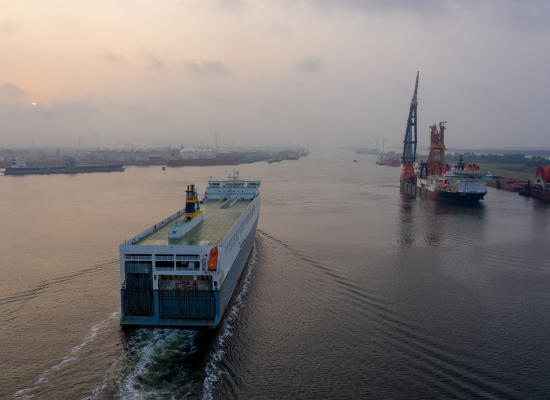The Clear Benefits of RoRo Capabilities on Ships

Roll-on/roll-off (RoRo) ships have revolutionized maritime logistics with their unique ability to transport vehicles and cargo efficiently across the seas. This versatility not only enhances operational capabilities but also provides significant economic and strategic benefits. In this article, we explore ten key advantages of integrating RoRo features into maritime vessels, highlighting how these benefits can transform and streamline shipping operations for enhanced global trade and responsiveness.
* Please send feedback/suggestions to editor @ shipuniverse.com
1. Increased Loading Efficiency
Driving On and Off: The Game-Changer in Port Operations
One of the standout advantages of RoRo ships is their ability to let vehicles and cargo drive directly onto and off the ship. This straightforward method cuts down significantly on the time spent loading and unloading compared to traditional lift-on/lift-off (LoLo) methods, where cranes and additional equipment are necessary to move cargo. For ship owners, this means a dramatic decrease in port turnaround times. Faster turnaround not only enhances operational efficiency but also increases the number of voyages a ship can undertake in a given period. This section explores how embracing RoRo capabilities can streamline your operations, keeping your ships moving and reducing idle time at ports.
2. Lower Labor Costs
Cutting Costs Without Cutting Corners
RoRo ships are not just about efficiency; they also bring substantial cost savings in terms of labor. The direct drive-on/drive-off method reduces the need for extensive manual handling of cargo. Fewer workers are needed on the docks, and there’s less dependency on heavy lifting equipment and cranes, which are both costly to operate and maintain. This reduction in labor and equipment use does not only lower operational costs but also decreases the potential for costly delays and cargo damage associated with handling errors. In this section, we delve into how RoRo ships can achieve these cost efficiencies and what it means for your bottom line. By leveraging RoRo capabilities, you can achieve a leaner, more cost-effective operation that still meets the high standards required in maritime logistics.
3. Improved Safety
Enhancing Safety on Deck and Beyond
The safety advantages of RoRo shipping are significant and multifaceted. By eliminating the need for cranes and heavy lifting equipment commonly used in traditional cargo handling, RoRo ships minimize the risks of accidents during loading and unloading operations. This method not only reduces the likelihood of cargo damage but also lowers the risk of injuries among the crew. A safer working environment leads to fewer work-related accidents and injuries, which can also reduce insurance claims and potential downtime associated with safety breaches. This section will highlight how switching to RoRo capabilities can contribute to a safer work environment, promoting better overall operational safety and compliance.
4. Enhanced Cargo Capacity
Maximizing Space, Maximizing Potential
RoRo vessels are ingeniously designed to make the most out of their cargo spaces. Unlike traditional ships where cargo needs to fit into fixed spaces like containers or flat racks, RoRo ships offer a flexible deck area that can accommodate a wide range of vehicle sizes and types—from standard cars and trucks to oversized machinery and military equipment. This ability to handle a diverse array of cargo types not only maximizes space utilization but also increases the ship’s versatility in terms of the freight it can carry. In this section, we’ll explore the design features of RoRo ships that enable this enhanced capacity and versatility, showing how they can expand your operational capabilities and open up new market opportunities.
5. Better Schedule Reliability
Keeping Time with RoRo
The efficiency of RoRo operations is a major asset when it comes to maintaining a tight ship schedule. The quick loading and unloading times allow RoRo vessels to adhere more closely to their planned arrival and departure times. This predictability is a boon for supply chain management, enabling better planning and coordination for shipping companies and their clients. In this section, we’ll delve into how the improved schedule reliability of RoRo ships enhances the overall supply chain efficiency, contributing positively to customer satisfaction and trust. Reliable schedules mean fewer delays, which helps maintain the integrity of the supply chain and meets increasingly demanding market expectations.
6. Reduced Environmental Impact
Driving Towards Greener Horizons
RoRo vessels offer several features that contribute to a reduced environmental impact, making them a more sustainable option in the maritime industry. Innovations in design and operation, such as more efficient fuel usage and advanced engine technologies, help minimize emissions. Additionally, the capacity to transport electric vehicles and other eco-friendly cargo further aligns RoRo operations with global sustainability goals. In this section, we’ll explore how adopting RoRo technology not only meets current environmental standards but also positions shipping operations to be more adaptable to future regulations and public expectations around environmental stewardship. This forward-thinking approach is essential as the industry moves towards a greener future.
7. Versatility in Cargo Handling
Broadening Horizons with Flexible Cargo Solutions
RoRo ships are not just for cars or trucks; their design allows them to carry a wide array of goods. Beyond wheeled and tracked vehicles, many RoRo vessels are equipped to handle static cargo on mafi trailers, enabling the transportation of goods that are typically challenging to move. This versatility extends the utility of RoRo ships across various industries, from automotive and manufacturing to agriculture and construction. In this section, we explore the adaptability of RoRo vessels in handling different types of cargo, illustrating how they can serve a broad spectrum of shipping needs. This flexibility not only maximizes cargo capacity but also enhances the ship’s ability to meet diverse market demands.
8. Increased Geographical Reach
Reaching Farther, Faster
The operational efficiencies of RoRo ships make them exceptionally suited for expanding a company’s geographical reach. Thanks to their ability to quickly load and unload cargo, these ships are particularly effective in ports that might not have the infrastructure to support more traditional cargo handling methods. This capability allows RoRo vessels to operate in more remote or less-developed ports, opening up new markets and trading opportunities for shipping companies. In this section, we delve into how RoRo capabilities can enhance your company’s flexibility in choosing routes and ports, facilitating access to new and emerging markets and strengthening global trade connections.
9. Enhanced Disaster Response
Rapid Response When It Matters Most
In emergency situations, time is of the essence, and RoRo ships excel in rapid deployment capabilities. Their ability to quickly load and unload vehicles and equipment makes them invaluable in disaster response scenarios. Whether it’s delivering emergency vehicles, medical supplies, or relief goods, RoRo vessels can arrive at disaster-stricken areas and start their operations without delay. This section highlights the critical role RoRo ships play in humanitarian aid and emergency response efforts, showcasing their capacity to support swift and effective relief operations. The versatility and speed of RoRo loading techniques allow these ships to be among the first responders, facilitating urgent recovery and aid distribution efforts.
10. Long-Term Cost Savings
Economic Efficiency Across the Board
The benefits of incorporating RoRo capabilities into maritime operations extend far beyond immediate operational improvements; they also lead to significant long-term cost savings. The efficiency in loading and unloading, reduced labor costs, improved safety, and increased cargo capacity all contribute to lower operational costs over time. Additionally, the reliability and flexibility provided by RoRo ships help shipping companies avoid costly delays and adapt to changing market demands without the need for additional investments. In this concluding section, we tie together all the advantages discussed, illustrating how RoRo ships contribute to overall cost-effectiveness and operational efficiency. These savings are crucial in a competitive market, ensuring that companies remain financially healthy and strategically ahead.
Incorporating RoRo capabilities into maritime vessels offers a compelling array of benefits that extend from improved operational efficiency to enhanced global reach and disaster response readiness. Each benefit discussed not only contributes to reducing operational costs but also plays a crucial role in elevating the strategic positioning of shipping companies in the competitive global market. As the shipping industry continues to evolve, the flexibility and efficiency provided by RoRo ships will undoubtedly remain integral to meeting the dynamic demands of worldwide logistics.

Do you have a Maritime Product or Service that may be of interest to Shipowners? Tell us about it here!
Do you have feedback or insights? Please reach out to editor @ shipuniverse.com



